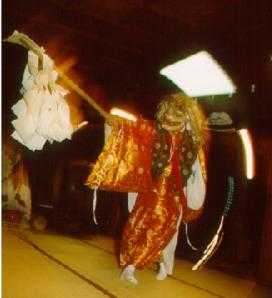日本の舞踊 - The Dance in Japan
Dancing in Japan has an exceptionally long history which goes back to ancient mythological times. The story says: The Goddess Ame no Uzume danced a comical, lewd dance on an upturned wooden tub. This dance was so comical that the other gods laughed loudly, causing Amaterasu Omikami to come out of her hiding place in the Rock-Cave of Heaven, returning light to the earth. Amaterasu had entered the cave in anger at Susanoo no Mikoto for insulting her. This dance and the sound it made is the root of Kagura, Japan’s oldest dance form.
日本における舞踊の歴史は神代にまでさかのぼります。アメノウズメノミコトがひっくりかえした木の桶の上でおもしろおかしく踊っていたところ、それを見ていた神々が笑い転げ、スサノオノミコトに侮辱され天の岩屋に隠れていたアマテラスオオミカミがその声を聞いて姿を現し地上に光が戻った、という神話が残っています。アメノウズメノミコトが踊った踊りとそのときの音楽が、日本最古の舞踊である「神楽」の起源です。
It was originally a dance performed by Shamanistic priestesses in their rituals. Not only is Kagura the origin of Shamanist and Shinto dances, but it has influenced theater dancing, especially Kabuki. It can also be seen in some ancient dances done in southeast Asia, as carried on in the traditional dances, Utagaki and Kagai. The Stamping Song (Toka) and the Dengaku dances of Okina and Onna, plus many others, also show the influence of Kagura.
神楽はもともと、巫女が神事で踊ったものでした。 神楽は、シャーマニストや神道の踊りの原形であるだけにとどまらず、演劇、中でも「歌舞伎」に大きな影響を与えました。東南アジアの古い踊りの中にも、「歌垣(うたがき)」、「燿歌(かがい)」で踊られたような神楽の要素を見つけることができます。「踏歌(とうか)」と呼ばれる足踏みをしながら歌う歌や、翁と嫗の踊り「田楽」を始めとして、数多くの舞踊に神楽の影響が色濃く残っています。
Toka came from China in the 8th century, proving once again the origins of culture in Japan. This Stamping Song was also rather obscene in character, which goes back to the dance of Ame no Uzume. The ties are there for us all to see. In the Heian Period, Dengaku, which was originally a fertility ritual and survives as the Taue Uta in rice planting rituals even today, became a dance for professionals. Later, it became so popular that it was danced in the streets to the music of flutes and drums. I have seen this interesting ritual.
踏歌は8世紀に中国から持ち込まれました。これもまた日本が中国から影響を受けたものの一つです。踏歌もアメノウズメノミコトの踊り同様に、こっけいな踊りです。さまざまな踊りに共通の要素を見ることができます。平安時代になると、元は豊作を願う儀式であったもので、今日でも「田植え歌」として続いている田楽が踊られるようになりました。田楽は後にたいへんな人気となり、笛や太鼓に合わせて街の通りでも踊られるようになりました。私も以前、この愉快な踊りを見たことがあります。
From the 14th century, a dance called Dengaku-No, using masked actors, appeared and was performed mostly at Shinto shrines. Also from China, was the dance Sarugaku, which first appeared in the Heian period (794 – 1191). This dance was the origin of the No drama, which also includes Dengaku elements. The dance was characterized by serious Buddhist thought. Thus we have found that Kabuki has a close relationship to Shinto and Kagura, while No is more closely related to Buddhism.
14世紀には、役者が面を着けて演じる「田楽能」が生まれ、主に神社で披露されました。また、平安時代(794〜1191)に中国から最初に伝わった「猿楽(さるがく)」もこのころ盛んでした。猿楽は「能」の基となったものですが、この能はまた田楽の要素も含んでいます。猿楽の踊りの根底に仏教の思想が流れていることは見逃せません。このように見てくると、歌舞伎は神道や神楽と密接な関係にあり、能は仏教と深く結び付いていることがわかります。
Kabuki is foremost “dance,” showing the influence of Kyogen, Bunraku and folk dances. No is more formal, and it is difficult to separate the dance from other movements on the stage. Kabuki was originated by Izumo no Okuni, from the Grand Shrine of Taisha, in 1603. Its point of greatest popularity was in Kyoto. Bunraku (puppet dance) became famous under the guidance of Uemura Bunrakuken in the 17th century.The No drama was developed by Kannami Kiyotsugu and his son, Zeami Motokiyo, in the 14th century and was admired by Yoshimitsu Ashikaga. He sponsored them, and they developed their own type of drama called No, which consists of both dance and music. That is roughly the history of “dance” in Japan. Some parts have been skipped over, but the general idea can be understood and appreciated.
歌舞伎は踊りが主要な要素であり、狂言、文楽を始めとするほかの民俗舞踊の影響を受けています。能は様式を重んじる演劇で、踊りと動作の境界がはっきりしていません。歌舞伎は1603年、出雲大社の巫女であった出雲阿国によって生み出され、京都で花開きました。文楽は、17世紀に植村文楽軒が広めました。そして能は、14世紀に観阿弥清次と世阿弥元清親子によって発展し、足利義満はこれをたいへん愛好しました。義満は二人の活動を支援し、彼らは独自の演劇として、踊りと音楽から成る能を確立しました。 以上が日本における舞踊の歴史の概略です。いくつか細かい箇所は省きましたが、大まかな流れは理解していただけると思います。
I hope that these articles stimulate some of our young people to develop an interest in culture and a desire to practice some art, to make sure it doesn’t die out. That would be wonderful!
私は今回これを読んだ若い人の中から自国の文化に関心を持ち、伝統的な舞踊を継承する人が現れ、日本の舞踊の灯をともし続けてくれることを願っています。もし実現すればどんなにすばらしいことでしょう。
